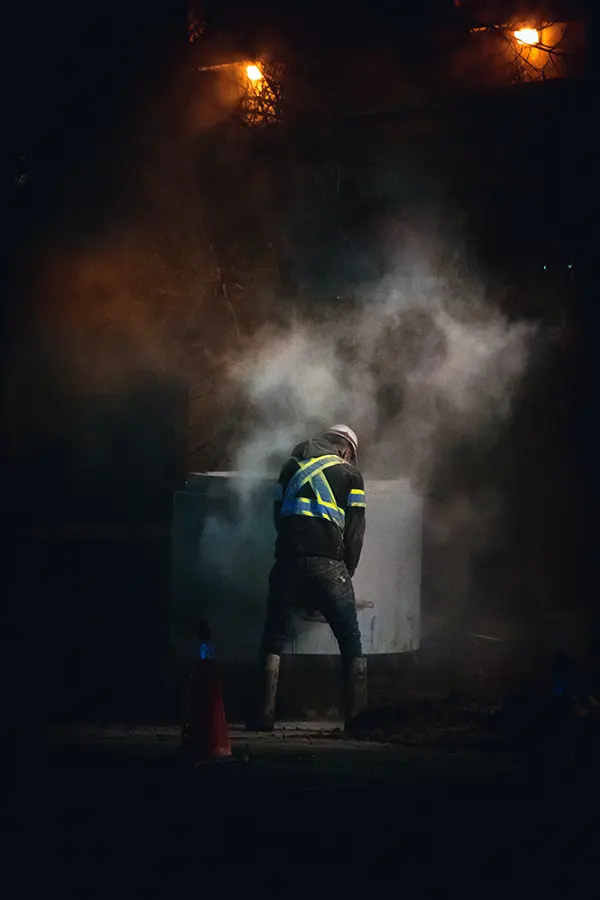Dealing with Construction Permits is the second part of the Building a House in Crete Guide, a brief, yet useful guide of the key stages that take place, from inception to completion and handover of a residential construction project.
This topic tracked the procedures, time, and cost to build a house in Crete—including obtaining the necessary licenses and permits, submitting all required notifications, requesting and receiving all necessary inspections, and obtaining utility connections.

Meeting the Standards That Matter the Most
From due diligence to property management, we partner with our clients to design, create and transform their properties in the ways that matter most to them.
This requires embedding local expertise, innovative total architecture design concepts, digital analytics, and state-of-the-art structural concepts into core processes and mind-sets, that help property owners and real estate investors to thrive.

Dealing With Construction Permits in Crete
A Paradigm Project
This section and its paradigm evaluate the procedures, time and cost to build a villa of 240.00 sq.m. in Apokoronas, Chania — including obtaining the necessary licenses and permits, submitting all required notifications, requesting and receiving all necessary inspections, and obtaining utility connections. At the start of a construction project, an effective and reliable project planning strategy defines the project scope and sets the baseline for budget and schedule. Using in-house proprietary tools and our own extensive experience we provide intelligent yet, reliable estimating. The Dealing with Construction Permits in Crete page is dedicated to those looking to understand the process and time required for a project in Crete, Greece.
DO NOT SET UNREALISTIC DEADLINES
The construction industry in Greece has been plagued by bureaucratic hurdles and legal wrangles and this is one of the main reasons that project deadlines cannot be realistic enough.
Unfortunately, the island of Crete and its construction sector is in not an exemption and several large commercial projects in Chania, Rethymnon, Agios Nikolaos and Heraklion are facing delays and bureaucratic obstacles that can also impact project deadlines and success.
An effective Project Planning strategy with a successful outcome can be only achieved through a structured process that includes multiple phases:
- Project Initiation and Planning
- Project Execution
- Monitoring & Control
- Finalization


Leading Sustainable Development
To exploit the potential of value creation, we strive to deliver sustainable, yet reliable real estate solutions by harnessing extensive data and market insights to execute on all aspects of a property’s purchase lifecycle and drive better results.
Agency: Hellenic Cadastre
Dealing With Construction Permits in Crete
1. OBTAIN PROOF OF OWNERSHIP, CADASTRAL EXTRACT AND CADASTRAL PLAN
Owners must submit proof of ownership when applying for the building permit in the form of an updated land title. Property owners must also obtain both a cadastral extract and a cadastral plan.
The cadastral extract, which must be submitted with the building permit application, depicts the wider area of the property with the National Cadastre Code (“ΚΑΕΚ”). The cadastral plan includes the site limits and other topographical information that an engineer would need in order to prepare the topographical survey map.
Time to Complete: 2 days
Associated Costs: € 45.00
Agency: Private Company – ARENCOS
Dealing With Construction Permits in Crete
2. OBTAIN TOPOGRAPHICAL SURVEY MAP
This is a very important step to check the land plot’s building potential and limitations, plot ratios, site coverage, height and other legal and building requirements.
Property owners must obtain a land use certificate and the street map from the Municipality before conducting the topographical survey to ensure that a property can be built on the purchased plot of land.</span>
Owners must first obtain the approved building terms from the Building Office, including a land use clearance before proceeding with the topographical survey map. Next, the Building Office must confirm that the property can be built on the intended land plot as well as any other specific building requirements for this land plot.
In fact, all buildings require the approved building terms. In terms of the land use clearance, this is required for all buildings except for residential buildings which are permitted anywhere.
A topographical survey is required to obtain an archaeological clearance certificate and a building permit in Greece.
Time to Complete: 1 – 2 weeks
Associated Costs: EUR 645.00 – EUR 1000.00 (depend on: property size and building regulations)
Agency: Archaeology Supervisory Authority
Dealing With Construction Permits in Crete
3. SUBMIT A PETITION FOR AN ARCHAEOLOGICAL CLEARANCE CERTIFICATE
In Greece, it is mandatory for some districts, neighborhoods, or areas to obtain approval from the Archaeology Supervisory Authority. The legal regulations (i.e. approved building terms) specify which districts/areas require such approval and which do not.
The case study property would likely be the built-in area that requires such approval. The property owner must submit a petition along with the required topographical survey map. Afterward, there is an inspection to verify that there are no archaeological artifacts on the land. A clearance certificate is issued after the Archaeology Supervisory Authority visit.
Time to Complete: 1 day
Associated Costs: Free of Charge
Obtain Archaeological Clearance Certificate: 2 – 4 weeks
Agency: Regional Fire Department
Dealing With Construction Permits in Crete
4. OBTAIN ACTIVE FIRE PROTECTION APPROVAL
In Greece, it is mandatory for some districts, neighborhoods, or areas to obtain approval from the Archaeology Supervisory Authority. The legal regulations (i.e. approved building terms) specify which districts/areas require such approval and which do not.
The case study property would likely be the built-in area that requires such approval. The property owner must submit a petition along with the required topographical survey map. Afterward, there is an inspection to verify that there are no archaeological artifacts on the land. A clearance certificate is issued after the Archaeology Supervisory Authority visit.
Time to Complete: 10 – 20 days
Associated Costs: Free of Charge

Project visibility and progress performance are so much more than a short update via email. More importantly, it plays a crucial role in project success and alignment between property owners, contractors, supervisors, and managers.
Project visibility and progress performance are so much more than a short update via email. More importantly, it plays a crucial role in project success and alignment between property owners, contractors, supervisors, and managers.
ARENCOS.me ensures project owners have a clear picture of the project’s progress, performance, including potential risks, distribution of responsibilities, and the overall project goals. It also enables project managers to uncover potential bottlenecks and other risks that may have a negative impact on project efficiency.
With ARENCOS.me you can learn:
- The work that’s been completed
- Real-time data
- Alerts and notifications
- Gantt timelines
- Time Tracking
- Status Reports
- The summary of the project budget and schedule
- A list of action items
- Any issues and risks, and what’s being done about them
Agency: Unified Social Security Fund (EFKA)
Dealing With Construction Permits in Crete
5. OBTAIN PROOF OF ADVANCED PAYMENT FROM THE UNIFIED SOCIAL SECURITY FUND
Social security is based on the size of the building which will provide for an approximate number of working days and the minimum pay for each worker.
The law requires each individual building project to be subjected to a pre-assessment and payment of expected social security expenses as a pre-condition to applying for a building permit.
This rule often involves repeated transactions with the Social Security until the proof of payment is obtained and the investor can move on with the project.
Time to Complete: Depend on the Project
Associated Costs: Depend on the Project
Agency: Building Office
Dealing With Construction Permits in Crete
6. REQUEST AND OBTAIN THE BUILDING PRE-APPROVAL FROM THE MUNICIPALITY MAP
At this point the builder’s architect submits general drawings of the building, topographic plan, and ownership documents to the Municipality. The Municipality’s engineer reviews the drawings and if everything is in compliance with the regulations, the Municipality issues the permissions approval.
This permit does not allow the builder to start construction. The permit is valid for one year, during which the engineer must submit detailed engineering drawings in order to get the final permission.
Time to Complete: 2 – 4 months
Associated Costs: Depend on the Project
Agency: Building Office
Dealing With Construction Permits in Crete
7. REQUEST AND OBTAIN THE BUILDING APPROVAL FROM THE MUNICIPALITY
The engineer submits detailed architectural, mechanical, structural drawings to the Municipality. The Municipality checks that all plans have been submitted and stores them to its database but does not proceed to a detailed review for their exact accuracy because under the Greek Property law regulations, the responsibility for the plans lies with the engineer.
At this point, the municipal tax of 1.5% of property value must be paid as well as other fees such as the health insurance of the workers. The proof of payment of the Social Security must be submitted when requesting the permit. Once the Municipality checks that all plans are submitted and all fees have been paid, the building permit is issued to the applicant.
Under Law Act 3919/2011 (Principle of professional freedom, abolition of unjustified restrictions on access to and pursuit of professions) Article 7, there is no minimum pay for any work or design performed by an engineer. However, the approved legal fees are estimated from the Town Planning.
Under the new law, ACT 7533/2013, Article 2, the municipality must issue the building permit within two days if all of the documents have been correctly submitted.
In practice, this takes up to 60 days.
Agency: Archaeology Supervisory Authority
Dealing With Construction Permits in Crete
8. NOTIFY ARCHAEOLOGY SUPERVISORY AUTHORITY OF COMMENCEMENT OF WORKS AND RECEIVE ON-SITE INSPECTION AT EXCAVATION
The Archaeology Supervisory Authority must be informed two or three weeks prior to the commencement of excavation work.
On the first day of excavation, a representative from the Archaeology Supervisory Authority will be on the construction site to verify that no archaeological artifacts have been discovered during the excavation works.
Time to Complete: 10 – 20 days
Associated Costs: No Fees
Whether you're planning to build your dream home, explore real estate opportunities, or understand local regulations, this section offers curated insights, FAQs, step-by-step guides, and tools to support confident and informed decision-making. Backed by years of hands-on experience and in-depth research, our resources are designed to help you navigate every stage of your project with clarity and peace of mind.
Property law in Greece is governed by a comprehensive legal framework that regulates the ownership, use, and transfer of real estate. Key aspects include the registration of property transactions in the Hellenic Cadastre, adherence to zoning laws and building regulations, and the distinction between private and public property rights.


Long-term success in Construction Projects & Real Estate requires extensive knowledge and critical thinking skills, while building the right teams, capabilities, and design models.
Agency: Municipality
Dealing With Construction Permits in Crete
9. NOTIFY THE MUNICIPALITY OF THE COMMENCEMENT OF WORKS
The Municipality is informed that construction will begin. Some municipalities demand a good performance guarantee that no damage will be done to the pavement or to adjoining municipal facilities.
This financial guarantee is returned after construction if no damage was made.
Time to Complete: 1 day
Associated Costs: Depend on the project size, type & location.

Agency: Board of Building Inspectors
Dealing With Construction Permits in Crete
10. REQUEST AND OBTAIN FOUNDATION WORK INSPECTION
The first inspection is at the foundation level right after the excavation works are completed. Inspections are requested in person at the Municipality by the engineer. It is possible to request the inspections electronically as the application is available online and can be sent to the Municipality via email; however, the current practice in Crete, Greece is a visit to the Municipality.
Next, the engineer completes a form with basic information (e.g. location, the total area of the building, etc.) and submits it to an employee at the Municipality. Usually, it is the same person who issued the building permit; there are several persons in charge and they are assigned to different areas of the city.
The Municipality then sends the file to the Ministry of Environment, Energy and Climate Change, which conducts a lottery among the certified engineers they have on file, and provides the name of the inspector to the Municipality.
The Municipality then informs the engineer about who the inspector will be.
Time to Complete: 20 – 30 days
Associated Costs: Depend on the project size, type & location.
Agency: Board of Building Inspectors
Dealing With Construction Permits in Crete
11. RECEIVE FINAL INSPECTION FROM BOARD OF BUILDING INSPECTORS AND RECEIVE COMPLETION CERTIFICATE
There is a last mandatory inspection to be performed by the independent engineer. Once the engineer has submitted the report of the final inspection, the construction permit is stamped and a copy is given to the owner to attest that the building was completed in conformity with the approved plan.
This stamped construction permit is needed in order to be connected to electricity.
Time to Complete: 20 – 30 days
Associated Costs: Depend on the project size, type & location.
Agency: Water and Sewerage Company
Dealing With Construction Permits in Crete
12. APPLY FOR WATER AND SEWAGE CONNECTION
The engineer submits a request for a new connection and pays a fee of approximately EUR 70.00.
The request must be accompanied by a recent copy of the building permit, coverage diagram, topographical survey map, and identification of the owner of the lot.
Time to Complete: 2 – 3 days
Associated Costs: EUR 50.00 – 70.00
DISCLAIMER
This is a personal opinion article from ARENCOS – not a peer-reviewed journal or a sponsored publication. We make no representations as to the accuracy, completeness, correctness, suitability, or validity of any information on this article and will not be liable for any errors, omissions, or delays in this information or any losses injuries, or damages arising from its display or use.
All information is provided on an as-is basis. It is the reader’s responsibility to verify his or her own facts. The views and opinions expressed on this page are those of the authors and do not necessarily reflect the official policy or position of any other agency, organization, employer, or company.
Assumptions made in the analysis are not reflective of the position of any entity other than the author(s) – and, since we are critically-thinking human beings, these views are always subject to change, revision, and rethinking at any time. Please do not hold us to them in perpetuity.
The authors and the webpage of ARENCOS are not to be held responsible for the misuse, reuse, recycled, and cited and/or uncited copies of content within this page by others.



